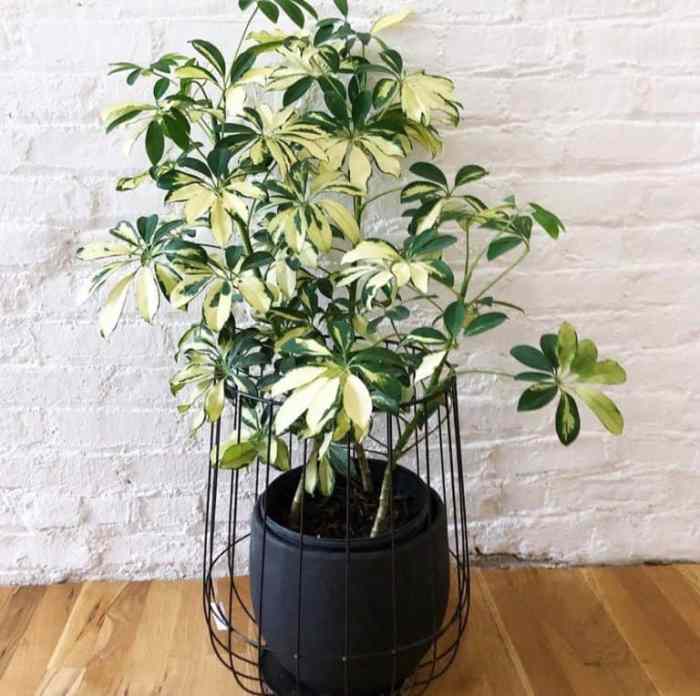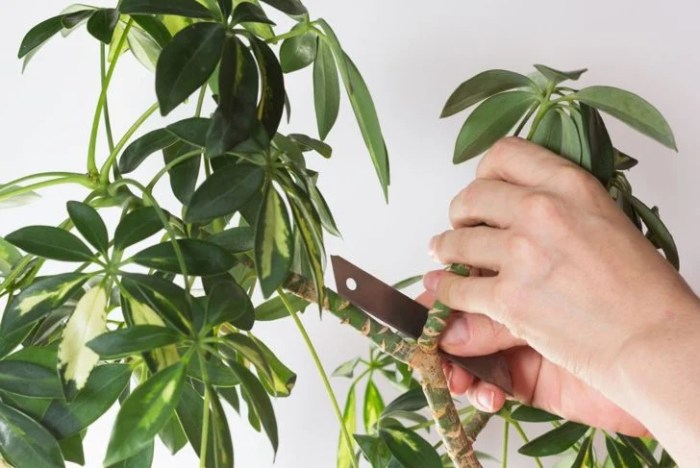How to trim umbrella plant – Discover the art of trimming umbrella plants and unlock their full aesthetic potential. This guide delves into the techniques, tips, and creative ideas for shaping, styling, and maintaining these elegant indoor plants. Get ready to transform your umbrella plants into stunning centerpieces that elevate any space.
Whether you’re a seasoned gardener or a plant enthusiast seeking inspiration, this comprehensive guide will equip you with the knowledge and techniques to cultivate healthy, visually appealing umbrella plants.
Pruning Techniques

Pruning is an essential part of caring for an umbrella plant. It helps to maintain the plant’s health and appearance, and encourages new growth. There are two main types of pruning shears: bypass shears and anvil shears. Bypass shears are best for making clean, precise cuts, while anvil shears are better for cutting through thicker stems.
When pruning an umbrella plant, it is important to start by removing any dead or damaged leaves. Then, you can trim back any stems that are too long or leggy. You can also prune the plant to shape it into a desired form.
When pruning, it is important to make clean cuts at a 45-degree angle. This will help to prevent the plant from becoming diseased.
Pruning Frequency
The frequency with which you need to prune an umbrella plant will vary depending on the plant’s growth rate and the desired shape. In general, it is best to prune the plant every few months. However, if the plant is growing rapidly, you may need to prune it more often.
When trimming an umbrella plant, use sharp, clean shears to make precise cuts. Remove any dead or yellowed leaves, as well as any stems that are crossing or rubbing against each other. For more detailed instructions on trimming palm plants, click here . Returning to the topic of umbrella plants, avoid over-trimming, as this can damage the plant.
Instead, trim regularly to maintain a healthy, attractive appearance.
Benefits of Pruning
Pruning an umbrella plant has a number of benefits, including:
- Improved health: Pruning helps to remove dead or diseased leaves and stems, which can help to improve the plant’s overall health.
- Enhanced appearance: Pruning can help to shape the plant into a desired form, and can also help to remove any unwanted growth.
- Increased growth: Pruning can help to encourage new growth, which can make the plant look fuller and healthier.
Shaping and Styling

An umbrella plant’s pliable stems and lush foliage provide ample opportunities for creative shaping and styling. Whether you desire a sleek and contemporary look or a whimsical and artistic expression, there are various techniques to transform your umbrella plant into a stunning focal point.
Training and Shaping
To train the plant’s growth and shape it to your desired form, employ the use of wire or stakes. Gently insert the wire or stake into the soil next to the stem and secure it to the stem with a soft tie.
Gradually adjust the wire or stake as the plant grows, guiding it towards the desired shape.
Topiaries
Topiaries are a classic way to add a touch of elegance and formality to any space. To create a topiary, start with a young umbrella plant and carefully prune the foliage into the desired shape. As the plant grows, continue to trim and shape it to maintain the desired form.
Bonsai
For those seeking a miniature work of art, the umbrella plant can be trained into a captivating bonsai. The key to creating a successful bonsai is patience and attention to detail. Prune the foliage regularly to maintain the desired shape and size, and carefully wire the branches to achieve the desired aesthetic.
Trimming umbrella plants requires removing dead or damaged leaves and stems to maintain a healthy and aesthetically pleasing plant. Similarly, pruning hibiscus plants involves selective removal of branches and stems to encourage new growth and improve overall plant health. For more information on how to prune hibiscus plants, visit how to prune hibiscus plants . Trimming umbrella plants can also help control the plant’s size and shape, promoting a bushier and more compact appearance.
Maintenance and Care: How To Trim Umbrella Plant

To ensure the health and beauty of your umbrella plant, it is essential to provide the appropriate growing conditions and care. This includes meeting its light, water, and temperature requirements, as well as fertilizing and repotting as needed. By following these guidelines, you can promote optimal growth and prevent common pests and diseases.
For a healthy and aesthetically pleasing umbrella plant, regular trimming is essential. Remove dead or yellowing leaves, and cut back any overly long stems to encourage new growth. Similarly, blueberry plants also require periodic pruning to maintain their productivity. Discover how to properly trim blueberry plants at how to trim blueberry plants to maximize fruit production and overall plant health.
Returning to umbrella plants, trimming promotes bushier growth and prevents the plant from becoming leggy.
Light
Umbrella plants prefer bright, indirect light. Direct sunlight can scorch their leaves, while insufficient light can lead to leggy growth. Choose a location near a window that receives plenty of natural light without exposing the plant to direct sun for extended periods.
Water
Water your umbrella plant thoroughly when the top inch of soil feels dry to the touch. Avoid overwatering, as this can lead to root rot. Allow the excess water to drain from the pot to prevent waterlogging. During the winter months, reduce watering frequency as the plant’s growth slows down.
Temperature
Umbrella plants thrive in warm temperatures between 65-80°F (18-27°C). They can tolerate brief periods of lower temperatures, but prolonged exposure to cold can cause damage. Protect your plant from cold drafts and sudden temperature fluctuations.
Fertilizing
Fertilize your umbrella plant once a month during the growing season (spring and summer) using a balanced liquid fertilizer. Dilute the fertilizer according to the manufacturer’s instructions. Avoid overfertilizing, as this can burn the roots.
Repotting
Repot your umbrella plant when it becomes rootbound, typically every 2-3 years. Choose a pot that is slightly larger than the previous one, with drainage holes to prevent waterlogging. Use a well-draining potting mix specifically designed for indoor plants.
Common Pests and Diseases
Umbrella plants are generally resistant to pests and diseases, but they can occasionally be affected by mealybugs, aphids, or spider mites. If you notice any pests, isolate the plant and treat it with an insecticidal soap or neem oil. Common diseases include root rot and leaf spot, which can be prevented by proper watering practices and providing good air circulation.
Propagation Methods

Propagating umbrella plants allows gardeners to create new plants from existing ones, expanding their collection or sharing them with others. There are two main methods for propagating umbrella plants: cuttings and division.
Propagation by Cuttings
This method involves taking stem cuttings from a healthy umbrella plant and rooting them in a suitable medium. The steps are as follows:
- Choose a healthy stem with several leaves.
- Cut a 4-6 inch section from the stem below a node (where the leaves attach).
- Remove the lower leaves from the cutting, leaving only the top few.
- Dip the end of the cutting in rooting hormone (optional).
- Plant the cutting in a well-draining potting mix.
- Keep the potting mix moist and provide bright, indirect light.
Propagation by Division
This method involves dividing an existing umbrella plant into two or more smaller plants. The steps are as follows:
- Remove the umbrella plant from its pot.
- Gently separate the root ball into two or more sections, ensuring each section has a healthy root system and several stems.
- Replant the divided sections in separate pots with well-draining potting mix.
- Water the plants thoroughly and keep them in a warm, bright location.
Both propagation methods have their advantages and disadvantages. Cuttings are easier to perform and require less space, but they can take longer to root and establish. Division is a faster method, but it can be more difficult to divide the root ball without damaging the plant.
Tips for Successful Propagation
- Use clean, sharp tools to prevent infection.
- Provide a warm, humid environment for cuttings to promote rooting.
- Keep the potting mix moist but not soggy.
- Be patient and allow time for the plants to establish.
Design Applications
Umbrella plants are versatile design elements that enhance the aesthetic appeal of various interior and exterior spaces. Their lush foliage and architectural form make them suitable for a range of decor styles, from contemporary to traditional.
In modern interiors, umbrella plants lend a touch of greenery and organic texture. Their tall, slender shape adds vertical interest and complements minimalist furnishings. In Scandinavian-inspired spaces, the plant’s clean lines and neutral color palette harmonize with the simplicity and functionality of the style.
Incorporating Umbrella Plants into Indoor Spaces
Indoor umbrella plants thrive in bright, indirect light and well-drained soil. They can be placed in corners, next to windows, or as statement pieces in entryways or living rooms. Their air-purifying qualities make them beneficial for health and well-being.
- Living Room:A large umbrella plant in a corner or beside a sofa adds a touch of greenery and creates a focal point.
- Bedroom:A smaller umbrella plant on a bedside table or dresser provides a calming presence and purifies the air.
- Office:Umbrella plants in planters or hanging baskets add a touch of nature and help reduce stress.
Outdoor Applications, How to trim umbrella plant
Umbrella plants can also be used effectively in outdoor spaces. They tolerate partial shade and can thrive in containers or directly in the ground. Their large leaves provide shade and create a lush, tropical atmosphere.
- Patio:A row of umbrella plants along a patio creates a privacy screen and adds a touch of greenery.
- Poolside:Umbrella plants in pots around a pool add a tropical touch and provide shade for relaxation.
- Entryway:A large umbrella plant in a planter at the entrance of a home creates a welcoming and inviting atmosphere.
Final Conclusion
Mastering the art of trimming umbrella plants empowers you to create unique and captivating indoor landscapes. By following the principles Artikeld in this guide, you can transform your umbrella plants into thriving, aesthetically pleasing additions to your home or office.
Embrace the joy of shaping and styling these versatile plants, and let their beauty and elegance enhance your living spaces.
FAQ Guide
How often should I trim my umbrella plant?
Regular trimming is essential to maintain a healthy and visually appealing umbrella plant. Aim to trim it every 2-3 months during the growing season (spring and summer).
What tools do I need to trim my umbrella plant?
Sharp, clean pruning shears or scissors are the essential tools for trimming umbrella plants. Ensure they are sharp to make precise cuts and prevent damage to the plant.
Can I use wire or stakes to shape my umbrella plant?
Yes, using wire or stakes can help guide the growth of your umbrella plant and create unique shapes. Gently insert the wire or stakes into the soil around the plant and use them to support and train the stems.